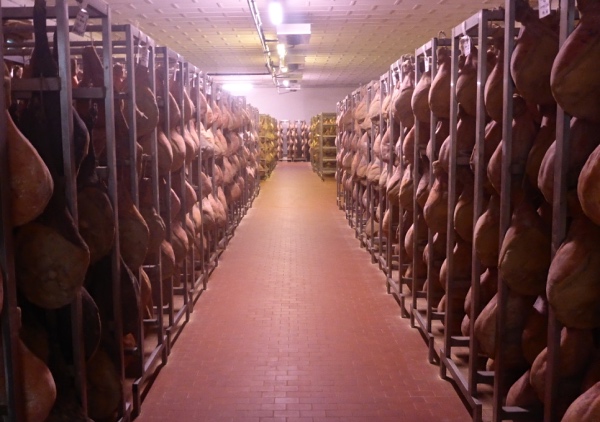A stay in Parma would most definitely NOT be complete without a visit to a certified Parmigiano Reggiano and Prosciutto di Parma Factory.
Similar to the way that the production of Champagne is very heavily regulated and controlled, so is the production of Parmigiano Reggiano cheese (parmesan cheese) and Prosciutto di Parma (Parma ham). These extremely natural products are produced exclusively in the Parma region and exported all over the world. They are renowned for their taste, quality and purity.
Matteo from ParmaLook Tours (hit them up for all types of tours, not just food, if you’re in Parma) took me to see how they’re made. Here is what I learnt about the fascinating process of making Prosciutto di Parma. Read about my learnings of Parmigiano Reggiano here.

“Hanging” with the hams
Prosciutto di Parma
An overview
Prosciutto di Parma or “Parma Ham” (prosciutto is Italian for ‘ham’) production is controlled by the Parma Ham Consortium. Every single leg of ham is checked by a tester before it can be given the official Parma Ham stamp.
After several years of gaining experience in the industry of curing meats, Giovanni Ferrari began his own factory and his own brand in 1978. The following year he gained certification with the consortium and has been producing delicious ham ever since.
Even simpler than Parmigiano Reggiano, Prosciutto di Parma has only 2 ingredients; the leg of the pig (skin still on) and salt. The unique feature of Parma ham is the air of the hills just south of Parma where it is made. This air that ventilates the rooms where the legs hang and gives the meat its distinct flavour. And any factories outside a specific radius around the hills cannot produce “Prosciutto di Parma”.

The Pigs
Unlike cows used for Parma cheese, the pigs for Parma ham production do not receive such a specific diet. They can come from all over Italy. When the legs arrive, Mr Ferrari assesses each one for quality and identifies the legs which will be used for the production of Prosciutto di Parma with a nail in the foot. The pigs used for Prosciutto di Parma must be at least 170kg, however some legs may not have enough fat (which works in the aging processes as a kind of insulation for the flavour) or may still be too small.
Inferior legs are used to make regular ham (Prosciutto as well, just not “Prosciutto di Parma”), culatello and crudo – basically just other types of cured pork. Mr Ferrari also buys legs of the Black Calabrian pigs to make the delicacy of Black Calabrian ham.

Black Calabrian prosciutto legs.
Add Salt
Prosciutto di Parma (and all the legs) legs have salt applied all over them which is then massaged into to meat using a special rolling machine.
The legs lay horizontal in the salt room (cold) for 20 days, during which time a second layer of salt is added.

Legs salting in the cold room.
Washing and The Sleeping Room
After about 20 days the legs are washed and then hung in a sleeping room (also cold) for about 70 days.
Aging
Then it’s off to the aging room (warmer, but still temperature controlled). Where the legs are allowed to age for 12 months and are moved through a series of rooms with slightly different humidity settings.
Mr Ferrari uses a piece of horse bone to assess the quality of the legs and aging process. He spears the legs in different places and the volatile, odorous components remain on the bone for him to smell.

Horse bone used for testing, plus official Parma Ham stamp.
Certification
After 12 months, a tester from the consortium comes to the factory to assess the quality of Mr Ferrari’s hams using the same type of tool made from horse bone. If the legs pass the tests then they will receive the official Parma ham stamp burned into the skin of the leg.
Like Parmigiano Reggiano, Prosciutto di Parma is often eaten a little older than 12 months – usually somewhere from 15-24 months.
Other products
Culatello is a type of cured pork that uses only a section of the leg which is wrapped in the bladder of the pig before curing. The Crudo ham is made from another section of the leg, also under similar methods to prosciutto di parma (simple ingredients, simple process).

Culatello
Mr. Ferrari doesn’t make any salami, although you can find many places that do.
So that’s it! Prosciutto di Parma in a nutshell! So simple really, and is a real treat if you’ve never eaten it before!
Matteo has Parmigiano cheese making in his blood and is a local to the region. His tours are full of fun stories and loads of detail. There was not one question I asked that he didn’t know the answer to! I highly recommend taking a tour with him – check out all the available tours on his ParmaLook website!

